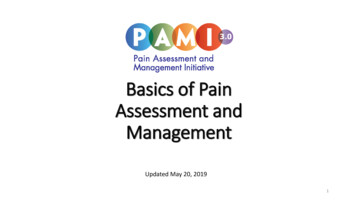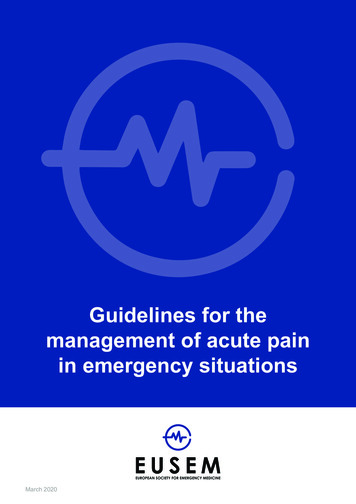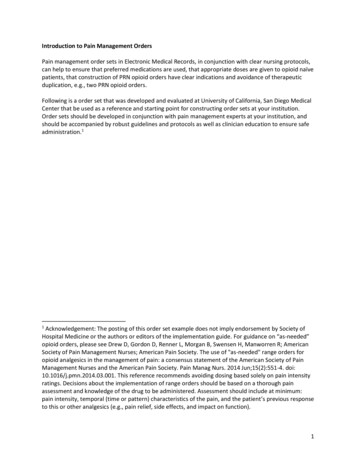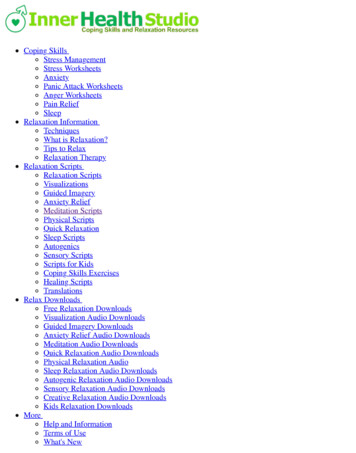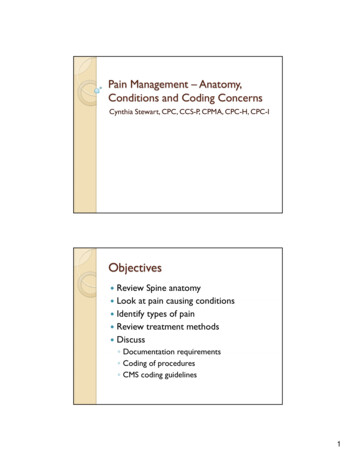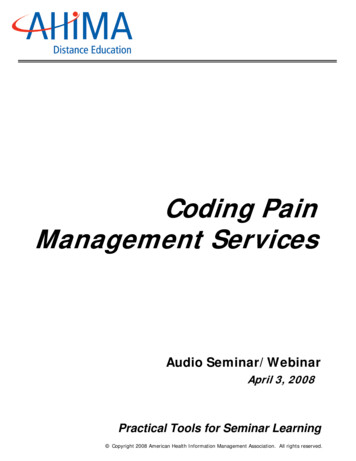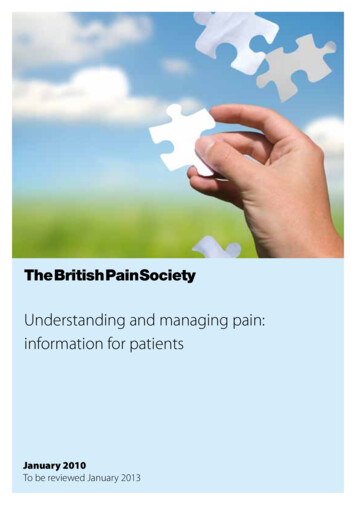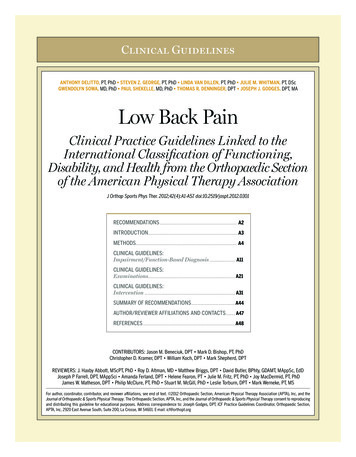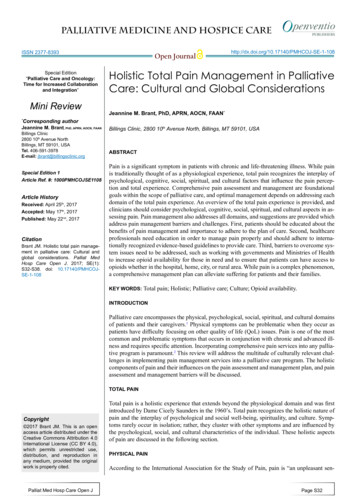
Transcription
PALLIATIVE MEDICINE AND HOSPICE CAREISSN 2377-8393Special Edition“Palliative Care and Oncology:Time for Increased Collaborationand Integration”Mini Review*Open olistic Total Pain Management in PalliativeCare: Cultural and Global ConsiderationsJeannine M. Brant, PhD, APRN, AOCN, FAAN*Corresponding authorJeannine M. Brant, PhD, APRN, AOCN, FAANBillings Clinic2800 10th Avenue NorthBillings, MT 59101, USATel. 406-591-3978E-mail: jbrant@billingsclinic.orgSpecial Edition 1Article Ref. #: 1000PMHCOJSE1108Article HistoryReceived: April 25th, 2017Accepted: May 17th, 2017Published: May 22nd, 2017CitationBrant JM. Holistic total pain management in palliative care: Cultural andglobal considerations. Palliat MedHosp Care Open J. 2017; SE(1):S32-S38. doi: 10.17140/PMHCOJSE-1-108Billings Clinic, 2800 10th Avenue North, Billings, MT 59101, USAABSTRACTPain is a significant symptom in patients with chronic and life-threatening illness. While painis traditionally thought of as a physiological experience, total pain recognizes the interplay ofpsychological, cognitive, social, spiritual, and cultural factors that influence the pain perception and total experience. Comprehensive pain assessment and management are foundationalgoals within the scope of palliative care, and optimal management depends on addressing eachdomain of the total pain experience. An overview of the total pain experience is provided, andclinicians should consider psychological, cognitive, social, spiritual, and cultural aspects in assessing pain. Pain management also addresses all domains, and suggestions are provided whichaddress pain management barriers and challenges. First, patients should be educated about thebenefits of pain management and importance to adhere to the plan of care. Second, healthcareprofessionals need education in order to manage pain properly and should adhere to internationally recognized evidence-based guidelines to provide care. Third, barriers to overcome system issues need to be addressed, such as working with governments and Ministries of Healthto increase opioid availability for those in need and to ensure that patients can have access toopioids whether in the hospital, home, city, or rural area. While pain is a complex phenomenon,a comprehensive management plan can alleviate suffering for patients and their families.KEY WORDS: Total pain; Holistic; Palliative care; Culture; Opioid availability.INTRODUCTIONPalliative care encompasses the physical, psychological, social, spiritual, and cultural domainsof patients and their caregivers.1 Physical symptoms can be problematic when they occur aspatients have difficulty focusing on other quality of life (QoL) issues. Pain is one of the mostcommon and problematic symptoms that occurs in conjunction with chronic and advanced illness and requires specific attention. Incorporating comprehensive pain services into any palliative program is paramount.2 This review will address the multitude of culturally relevant challenges in implementing pain management services into a palliative care program. The holisticcomponents of pain and their influences on the pain assessment and management plan, and painassessment and management barriers will be discussed.TOTAL PAINCopyright 2017 Brant JM. This is an openaccess article distributed under theCreative Commons Attribution 4.0International License (CC BY 4.0),which permits unrestricted use,distribution, and reproduction inany medium, provided the originalwork is properly cited.Palliat Med Hosp Care Open JTotal pain is a holistic experience that extends beyond the physiological domain and was firstintroduced by Dame Cicely Saunders in the 1960’s. Total pain recognizes the holistic nature ofpain and the interplay of psychological and social well-being, spirituality, and culture. Symptoms rarely occur in isolation; rather, they cluster with other symptoms and are influenced bythe psychological, social, and cultural characteristics of the individual. These holistic aspectsof pain are discussed in the following section.PHYSICAL PAINAccording to the International Association for the Study of Pain, pain is “an unpleasant sen-Page S32
PALLIATIVE MEDICINE AND HOSPICE CAREOpen JournalISSN 2377-8393sory and emotional experience associated with actual or potential tissue damage, or described in terms of such damage.”While physical pain is the physiological component, this definition emphases the importance of the physical impact on theentire person.3 Other deleterious physical symptoms can occurin conjunction with pain. The most common of these is fatigue.4Dyspnea, drowsiness, sleep disturbance, nausea, and loss ofappetite are other physical symptoms that need to be assessedwhen an individual is experiencing pain.5-7 Depression is a common problem that also co-occurs with pain. Current research isfocusing on underlying. mechanisms that may be responsible forco-occurring symptoms, also known as symptom clusters. Mostimportantly, clinicians should recognize that pain may contribute to other symptoms; thereby, managing pain may eliminateother symptoms as well.PSYCHOLOGICAL PAINEmotional distress, depression, anxiety, uncertainty, and hopelessness are all forms of psychological pain that can co-occurwith physical pain with depression being one of the most common psychological symptoms.8 One systematic review indicatedthat the co-occurrence of pain and depression is approximately36.5%. The more intense the pain was, the more likely the individual was to be depressed (p 0.05). Patients with depressionmay use more affective words to describe pain such as fearful.QoL has also been shown to be worse in those with both painand depression.9 Depression is also found to be a significant barrier to manage pain, underscoring the importance of managingdepression in order to improve pain.10According to the National Comprehensive Cancer Network, distress is an “unpleasant experience of a mental, physical, social, or spiritual nature.” It can affect the way an individual thinks, feels, or acts and can make coping more difficult.11Distress should be screened for each patient visit.While pain canbe a reason for the distress, other reasons should also be notedas all factors can increase the occurrence and severity of thepain experience.12,13 In one study, concurrent physical symptomsand psychosocial distress occurred in patients attending a cancer pain clinic compared to those who did not attend the painclinic.14 Clinicians should recognize that pain and distress commonly co-occur.COGNITIVE-BEHAVIORAL INFLUENCESCognitive-behavioral responses to pain are additional components of holistic total pain. One cognitive response could be thepatient’s failure to acknowledge the pain for fear that this represents progressive disease. Other patients may feel the need betough and endure the pain. This cognitive denial of pain, whichcould be stemmed from cultural or spiritual beliefs, can interferewith optimal management. The cognitive-behavioral domaincan also be positively used to address overall pain. Cognitivebehavioral therapy that can be used to ameliorate pain in somepatients includes building self-esteem, optimism, and mastery ofpain control.15Palliat Med Hosp Care Open ophizing is another recognized cognitive traitassociated with pain. Patients who exhibit this behavior ruminate or exaggerate their pain, and catastrophizing is commonlylinked to depression.16 Cognitive-behavioral approaches shouldbe considered in the overall pain management plan.SOCIAL INFLUENCESThe social context of cancer pain is well-recognized. Pain canlead to social isolation, disengagement from meals and other activities, caregiver burden, and inability to afford analgesics tocontrol the pain. Adequate social support is predictive of lessdistress, depression, and anxiety.17 The National ComprehensiveCancer Network (NCCN) Distress thermometer includes measurement related to social distress. Again, distress assessmentshould be incorporated into daily practice. When social distressis detected, psychosocial interventions, including education andcoping-skills training may be useful adjuncts to medical management of pain.SPIRITUAL AND RELIGIOUS INFLUENCESSpirituality, defined as the need to be connected to a higherpower, has a significant association with pain. Religion, on theother hand, includes the practices associated with an organizedsystem. Spiritual and religious influences of pain may vary byreligion and even by individual belief within a religion. For example, some patients may feel that God is punishing them, andthat their reward in heaven will be greater if they endure pain.In the Muslim faith, some patients feel that pain is considered apunishment from God; however, Islamic teachings report differently.18 Spiritual and religious beliefs can therefore, be misperceived and influence how an individual perceives the pain andmanages the pain. Often a religious leader or chaplain can explore spiritual and religious questions with patients individually,which can add to the overall pain management plan.Hope is a concept commonly associated with spirituality and is an important component of most religious faiths.Studies reveal hope to be positively correlated with spiritualwell-being (p 0.01) and negatively correlated with average painintensity (p 0.02), worst pain intensity (p 0.01), pain interference with function (p 0.05), anxiety (p 0.01), and depression(p 0.01). Depression especially influenced this relationship,which reinforces the need to manage pain in a holistic manner.19CULTURAL INFLUENCESPain expression is an individualized experience, which is influenced by culture or ethnicity. It can represent the individual’sconceptual meaning of pain, pain perception, and coping abilities. One systematic review found that some ethnic groups expressed more severe pain. Asians tended to normalize painwhereas westerners were more likely to seek help for their pain.20A second recent systematic review of 26 studies compared painresponses of African Americans (AA) to non-Hispanic Whites(NHW) and found AAs demonstrated lower pain tolerance.21Page S33
PALLIATIVE MEDICINE AND HOSPICE CAREOpen JournalISSN 2377-8393Another large meta-analysis of 22 studies found Asian patientsto have more pain barriers compared to Western patients suchas concerns about cancer progression, drug tolerance, fatalism,and pain management barriers.22 This could provide rationale forwhy Asians may try to normalize pain.Overall, patients from some ethnic or cultural groupsmay have difficulty in communicating with their care-providersabout pain.23 Providers as well may have barriers toward patients who are ethnically or racially different than themselves.For example, in one study, Western Caucasian physicians werenoted to underestimate pain in 75% of AAs and 64% of Hispanics.24 These patients also reported suboptimal pain management.These overall differences underscore the need for a patient-centered approach for the management of pain.PAIN MANAGEMENT BARRIERSThe holistic components of pain can strongly influence the individual pain experience. These influences can contribute to someof the major barriers that interfere with optimal pain management in many regions around the world. Pain assessment andmanagement barriers commonly occur in most cultures and involve three levels: 1) patient and caregiver, 2) healthcare professional, and 3) systems. Sadly, these barriers have existed forhttp://dx.doi.org/10.17140/PMHCOJ-SE-1-108more than 20 years and have not been adequately addressed.For patients and caregivers, stoicism, failure to reportpain, and fear about addiction are common barriers. For healthcare professionals, failure to consistently assess pain, lack ofknowledge about pain management strategies, fears of addictionand beliefs that pain is an inevitable component of cancer arecommon problems. When supportive care services are availablefor pain and symptom management, many patients may not evenknow they exist, because physicians and other professionals maynot consistently refer patients to these services.25,26 In regardsto systems, opioids and other management options may not befully available in some countries. Opioid use outside of Western societies is minuscule in most of the world (Figure 1). Tightregulations through the governmental agencies such as the Ministry of Health can be a barrier for optimal pain management.27Additional efforts that address these barriers are imperative toachieve meaningful progress.28INTERVENTIONS TO ADDRESS BARRIERSMultiple efforts to address pain management barriers are occurring around the globe. Education for all stakeholders is important to overcome both knowledge and attitude barriers. Education, guideline adherence, medication coaching, and addressingFigure 1: Opioid Availability: A Global Look.Palliat Med Hosp Care Open JPage S34
PALLIATIVE MEDICINE AND HOSPICE CAREOpen SSN 2377-8393fears of addiction and substance use disorders are all potentialsolutions for improving pain management quality.tion of interventions that is most beneficial and cost-effective forpatients and healthcare systems.34PATIENTS AND CAREGIVERSAnalgesic Self-ManagementEducational ApproachesOne of the biggest patient level barriers is not following thepain management plan of care. Both patients and caregiverscan influence the self-management plan. Common reasons fornot following the plan are fear of addiction, forgetfulness, anduntoward side effects. Studies found that analgesic adherenceranges from 49% to 91% for long acting opioids and as low as20% for as needed pro re nata (PRN) opioids.35-37 Depressionand older age were found to be predictors of not following thepain management plan in one study. Additionally, patients wereunsure about what their exact medication regimen was comprised of and therefore, it was not followed.36 Reasons for lackof self-management should be carefully assessed with patientsand caregivers. Education about addiction, the importance ofcomfort, and clear instructions about the pain management planshould be provided. The overall message should not be paternalistic but rather coaching and collaborative.38Educational efforts are occurring worldwide. The Middle Eastern Cancer Consortium has played a role to provide pain management education throughout the Middle East for the past twodecades.27,29 Palliative care education includes the managementof pain has also been instrumental in that same region.2 Education includes conducting a comprehensive pain assessmentand employing optimal management strategies for pain relief.Discussions should also ensue about belief systems regardingpain and fears of addiction which can assist to bridge the gapbetween suffering and comfort. Two systematic reviews (21 trials) and meta-analyses (15 trials included in one meta-analysis,26 in another) found that education for patients, caregivers, andhealthcare professionals can decrease pain intensity,30-32 and thegreater the dose of the educational intervention, the better thepain outcomes.31 In regards to patient education, repeated faceto-face interactions seem to be the most effective compared towritten information.33 When education is consistently delivered,sustained pain improvements have been demonstrated over time.Healthcare professionals should include pain education in dailycare.32Education plays an important role in the overall management of pain. More studies and educational models shouldbe proposed to suggest how best to implement educational interventions within the scope of care and to determine the combina-HEALTH CARE PROFESSIONALSEducationNot believing the patient’s report of pain is a significant barrierthat can significantly impact the quality of pain management.39Health care professionals should have a therapeutic relationshipwith the patient, and listen carefully to the patient’s report ofpain. While substance use disorders and addiction exist, the undermanagement of pain in palliative care patients is substantialTable 1: Pain Terms to Know Data from American Pain Society, 2008; Federation of State Medical Boards of the United States, 2013; InternationalAssociation of the Study of Pain; 2014.Aberrant BehaviorAbuseBehaviors indicative of prescription drug abuse, some of which are more indicative of abuse or addiction.Use of a drug for nontherapeutic purposes to obtain psychotropic effects.AddictionA primary, chronic, neurobiologic disease, with genetic, psychosocial, and environmental factors influencing its development and manifestations. It is characterized by behaviors that include one or more of the following: impaired control overdrug use, compulsive use, continued use despite harm, and craving.DiversionUnlawful channeling of pharmaceuticals from legal sources to the illegal marketplace.Illicit SubstanceA substance that is not legally permitted or authorized.MisuseUse of a prescription drug without a prescription or in a manner that is not prescribed.NarcoticAn archaic term for an opioid analgesic; currently the term is used by law enforcement to describe illicit substances with apotential for abuse such as heroin, cocaine, or methamphetamine.OpioidA medication that exerts its primary pharmacologic response by its binding to the opioid receptors in the central nervoussystem (CNS). This term is preferred to the term “narcotic”.Physical DependenceA state of adaptation manifested by a drug class specific withdrawal syndrome that can be produced by abrupt cessation,rapid dose reduction, decreasing blood level of the drug, and/or administration of an antagonist.PseudoaddictionPattern of drug-seeking behavior in patients with pain who are receiving inadequate pain management; can be mistakenfor addiction.TamperingManipulating a pharmaceutical to change its drug delivery performance.ToleranceA state of adaptation in which exposure to a drug induces changes that result in a diminution of one or more of the drug’seffects over time.Palliat Med Hosp Care Open JPage S35
PALLIATIVE MEDICINE AND HOSPICE CAREOpen SSN 2377-8393and professionals should advocate for better pain relief in theirregions.40 Understanding the differences between addiction, tolerance, and physical dependence, and understanding the differences of addiction and other high risk behaviors is the first stepin overcoming this knowledge gap. A list of terms is included inTable 1.3,41,42 When clinicians have this knowledge, they can theneducate patients and caregivers which will decrease some of theoverall fears of addiction, especially in palliative and end-oflife care. Education has been shown to improve attitudes aboutpain.43 Finally, education is important in improving health careprofessional knowledge and opioids, which opioids to prescribe,and co-analgesics that can improve overall comfort. Pain management is both an art and a science and requires specific education. Clinical guidelines are one way to educate clinicians andensure that all patients receive consistent, quality pain management.Clinical Practice Guideline Adherence. While a plethora of guidelines exist to assist clinicians in managing pain,41,44,45studies reveal that only 22% to 45% of clinicians use a painguideline.26,46 Some efforts are underway to encourage cliniciansto use practice guidelines. In one study setting, nurse practitioners received weekly feedback on patient pain scores and howconsistent their recommended interventions aligned with clinical guidelines. This audit and feedback intervention resultedin significantly less overall pain interference and interferencewith general activity and sleep. Satisfaction with pain relief increased significantly from 68.4% to 95.1%.47 Environments andstaff culture are important considerations prior to implementingevidence-based guidelines.48 Electronic reminders and tools totranslate guidelines into practice are additional strategies, butfurther work is needed in this area.49HEALTHCARE SYSTEMSHealthcare systems around the world can interfere with qualitypain management. Laws regarding who can prescribe opioids,which opioids are available, and access issues, especially for rural populations can significantly influence care. One of the mostimportant systems issues is opioid availability, which is furtherdiscussed below.Opioid AvailabilityOpioids are the mainstay of pain management, and yet opioidsare not widely available in many countries. Opioids are usuallyregulated by each country’s government, often the Ministry ofHealth (MOH). Historical problems with opioid addiction, otherfears, and current use influence the amounts of opioids allottedin each country. Economics play an additional role. Some of thepoorest countries in the world are often found to have the lowest opioid amounts per capita.50 A recent analysis of global morphine consumption found significant disparity between high andlow-income countries. Overall, 21% of the world’s population(high income) consumed 92% of the total global morphine. Andyet the majority of cancer deaths (70%) occur in low to middlePalliat Med Hosp Care Open Jincome countries (LMICs),51,52 demonstrating a desperate needto increase opioid availability and pain management efforts inthese countries. However, richer nations can also have restrictions on opioids, and so each country should be individually assessed. Figure 1 includes opioid availability comparisons for avariety of countries around the world. To note is the high consumption of Western countries versus those in other parts of theworld. Turkey has recently opened a morphine production plant,hoping to increase the availability of opioids in Middle East.Nurses and other health care professionals are meeting with theirMOH to try and increase opioids in their respective regions inorder to improve pain management in palliative care patients.SUMMARYA number of challenges interfere with quality pain managementfor palliative care patients. Understanding the holistic experience of pain is the first step in addressing the physical, emotional, social, spiritual, and cultural components of the pain experience. Once holistic total pain is embraced, addressing barriersis imperative to improve pain management efforts. Patient andcaregiver related barriers, clinician barriers, and systems barriers.REFERENCES1. World Health Organization. Palliative Care. 2017; /. Accessed January9, 2017, 2017.2. Brant J. Strategies to manage pain in palliative care. In:O’Connor M, Lee S, Aranda S, eds. Palliative Care Nursing:A Guide to Practice, 3rd ed. Victoria, Australia: Ausmed; 2012:93-113.3. International Association for the Study of Pain. Definition ofPain. 2014.4. Reyes-Gibby CC, Aday LA, Anderson KO, Mendoza TR,Cleeland CS. Pain, depression, and fatigue in community-dwelling adults with and without a history of cancer. J Pain Symptom Manage. 2006; 32(2): 118-128. doi: 10.1016/j.jpainsymman.2006.01.0085. Reyes-Gibby CC, Swartz MD, Yu X, et al. Symptom clustersof pain, depressed mood, and fatigue in lung cancer: Assessingthe role of cytokine genes. Support Care Cancer. 2013; 21(11):3117-3125. doi: 10.1007/s00520-013-1885-56. Dong ST, Butow PN, Costa DS, Lovell MR, Agar M. Symptom clusters in patients with advanced cancer: A systematic review of observational studies. J Pain Symptom Manage. 2014;48(3): 411-450. doi: 10.1016/j.jpainsymman.2013.10.0277. Yennurajalingam S, Kwon JH, Urbauer DL, Hui D, ReyesGibby CC, Bruera E. Consistency of symptom clusters amongPage S36
PALLIATIVE MEDICINE AND HOSPICE CAREOpen JournalISSN 8advanced cancer patients seen at an outpatient supportive careclinic in a tertiary cancer center. Palliat Support Care. 2013;11(6): 473-480. doi: 10.1017/S1478951512000879hope, pain, psychological distress, and spiritual well-being inoncology outpatients. J Palliat Med. 2013;16(2): 167-172. doi:10.1089/jpm.2012.02238. Syrjala KL, Jensen MP, Mendoza ME, Yi JC, Fisher HM,Keefe FJ. Psychological and behavioral approaches to cancerpain management. J Clin Oncol. 2014; 32(16): 1703-1711. doi:10.1200/jco.2013.54.482520. Kwok W, Bhuvanakrishna T. The relationship between ethnicity and the pain experience of cancer patients: A systematicreview. Indian Journal of Palliative Care. 2014; 20(3): 194-200.9. Laird BJ, Boyd AC, Colvin LA, Fallon MT. Are cancer painand depression interdependent? A systematic review. Psychooncology. 2009; 18(5): 459-464. doi: 10.1002/pon.143121. Rahim-Williams B. Beliefs, behaviors, and modificationsof type 2 diabetes self-management among African Americanwomen. J Natl Med Assoc. 2011; 103(3): 203-215. doi: 10.1016/S0027-9684(15)30300-X10. Kwon JH, Oh SY, Chisholm G, et al. Predictors of high scorepatient-reported barriers to controlling cancer pain: A preliminary report. Support Care Cancer. 2013; 21(4): 1175-1183. doi:10.1007/s00520-012-1646-x22. Chen CH, Tang ST, Chen CH. Meta-analysis of culturaldifferences in Western and Asian patient-perceived barriers tomanaging cancer pain. Palliat Med. 2012; 26(3): 206-221. doi:10.1177/026921631140271111. National Comprehensive Cancer Network. Distress management. 2014; http://www.nccn.org/professionals/physician gls/pdf/distress.pdf. Accessed May 15, 2017, 2017.23. Im EO, Ho TH, Brown A, Chee W. Acculturation and thecancer pain experience. J Transcult Nurs. 2009; 20(4): 358-370.doi: 10.1177/104365960933493212. Maher NG, Britton B, Hoffman GR. Early screening in patients with head and neck cancer identified high levels of painand distress. J Oral Maxillofac Surg. 2013;71(8):1458-1464.24. Rahim-Williams B, Riley JL 3rd, Williams AK, FillingimRB. A quantitative review of ethnic group differences in experimental pain response: Do biology, psychology, and culturematter? Pain Med. 2012; 13(4): 522-540. doi: 10.1111/j.15264637.2012.01336.x13. Lin S, Chen Y, Yang L, Zhou J. Pain, fatigue, disturbed sleepand distress comprised a symptom cluster that related to qualityof life and functional status of lung cancer surgery patients. JClin Nurs. 2013; 22(9-10): 1281-1290. doi: 10.1111/jocn.1222814. Waller A, Groff SL, Hagen N, Bultz BD, Carlson LE. Characterizing distress, the 6th vital sign, in an oncology pain clinic.Curr Oncol. 2012; 19(2): e53-e59. doi: 10.3747/co.19.88215. Schwabish SD. Cognitive adaptation theory as a means toPTSD reduction among cancer pain patients. J Psychosoc Oncol. 2011; 29(2): 141-156.16. Badr H, Gupta V, Sikora A, Posner M. Psychological distressin patients and caregivers over the course of radiotherapy forhead and neck cancer. Oral Oncol. 2014; 50(10): 1005-1011 doi:10.1016/j.oraloncology.2014.07.00317. Carlson LE, Waller A, Groff SL, Giese-Davis J, Bultz BD.What goes up does not always come down: Patterns of distress,physical and psychosocial morbidity in people with cancer overa one year period. Psychooncology. 2013; 22(1): 168-176. doi:10.1002/pon.206818. Leong M, Olnick S, Akmal T, Copenhaver A, Razzak R.How Islam influences end-of-life care: Education for palliativecare clinicians. J Pain Symptom Manage. 2016; 52(6): 771-774e773. doi: 10.1016/j.jpainsymman.2016.05.03419. Rawdin B, Evans C, Rabow MW. The relationships amongPalliat Med Hosp Care Open J25. Kumar P, Casarett D, Corcoran A, et al. Utilization of supportive and palliative care services among oncology outpatientsat one academic cancer center: Determinants of use and barriersto access. J Palliat Med. 2012; 15(8): 923-930. doi: 10.1089/jpm.2011.021726. Luckett T, Davidson PM, Boyle F, et al. Australian surveyof current practice and guideline use in adult cancer pain assessment and management: Perspectives of oncologists. Asia Pac JClin Oncol. 2012; 10(2): e99-e107. doi: 10.1111/ajco.1204027. Silbermann M. Opioids in middle eastern populations. AsianPac J Cancer Prev. 2010; 11(Suppl 1): 1-5.28. Breuer B, Fleishman SB, Cruciani RA, Portenoy RK. Medical oncologists’ attitudes and practice in cancer pain management: A national survey. J Clin Oncol. 2011;29(36): 4769-4775.doi: 10.1200/JCO.2011.35.056129. Silbermann M, Pitsillides B, Al-Alfi N, et al. Multidisciplinary care team for cancer patients and its implementation inseveral Middle Eastern countries. Ann Oncol. 2013; 24(Suppl7): vii41-vii47. doi: 10.1093/annonc/mdt26530. Bennett MI, Bagnall AM, Closs SJ. How effective are patient-based educational interventions in the management ofcancer pain? Systematic review and meta-analysis. Pain. 2009;143(3): 192-199. doi: 10.1016/j.pain.2009.01.016Page S37
PALLIATIVE MEDICINE AND HOSPICE CAREOpen JournalISSN 2377-839331. Cummings GG, Olivo SA, Biondo PD, et al. Effectivenessof knowledge translation interventions to improve cancer painmanagement. J Pain Symptom Manage. 2011; 41(5): 915-939.doi: 10.1016/j.jpainsymman.2010.07.01732. Borneman T, Koczywas M, Sun VC, Piper BF, Uman G,Ferrell B. Reducing patient barriers to pain and fatigue management. J Pain Symptom Manage. 2010; 39(3): 486-501. doi:10.1016/j.jpainsymman.2009.08.00733. Falvo DR. Effective Patient Education: A Guide to IncreasedAdherence. Sudbury, MA: Jones & Bartlett; 2011.34. Bennett MI, Flemming K, Closs SJ. Education in cancer painmanagement. Curr Opin Support Palliat Care. 2011; 5(1): 2024. doi: 10.1097/SPC.0b013e328342c60735. Miaskowski C, Dodd MJ, West C, et al. Lack of adherencewith the analgesic regimen: A significant barrier to effective cancer pain management. J Clin Oncol. 2001; 19(23): 4275-4279.doi: 10.1200/JCO.2001.19.23.427536. Yoong J, Traeger LN, Gallagher ER, Pirl WF, Greer JA,Temel JS. A pilot study to investigate adherence to long-actingopioids among patients with advanced lung cancer. J PalliatMed. 2013; 16(4): 391-396. doi: 10.1089/jpm.2012.040037. Meghani SH, Bruner DW. A pilot study to identify correlatesof intentional versus unintentional nonadhe
lenges in implementing pain management services into a palliative care program. The holistic components of pain and their influences on the pain assessment and management plan, and pain assessment and management barriers will be discussed. TOTAL PAIN Total pain is a holistic experience that extends beyond the physiological domain and was first



